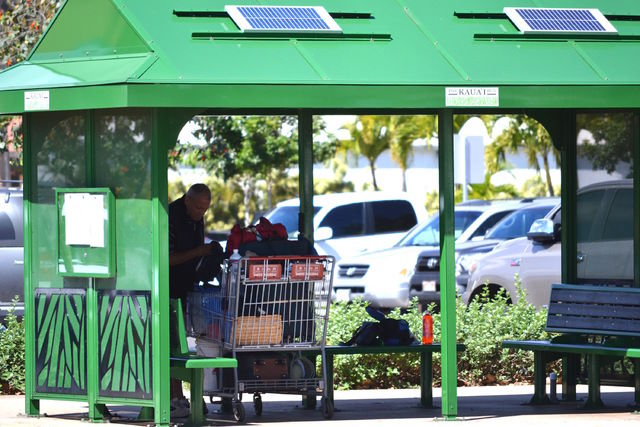HONOLULU — Hawaii is exploring a measure that would allow homeless people to camp in designated “safe zones” or to rent space in private driveways and yards, as part of an array of offbeat solutions to its homelessness crisis, which ranks worst in the nation.
However, some agencies who serve homeless on the Garden Isle say they aren’t supporting the measure.
“They’re preferring to see funds and attention directed more to permanent housing. Officially, we’re just watching to see what’s happening with that,” said Debra de Luis, secretary of Kauai Community Alliance, an organization which works to alleviate the homeless problem in the state. “It is a challenge when you designated safe zones or get people camping.”
The ideas run contrary to a trend among cities to pass laws criminalizing homelessness, said Eric Tars, senior attorney at the National Law Center on Homelessness and Poverty. A handful of cities have tried setting up “safe zones” or sanctioned homeless encampments that provide access to sanitary facilities, social services and security, but it’s unusual for a state to do so, Tars said.
“I think everyone’s just trying to nibble away at the edge of this homeless issue, providing as many alternatives as possible,” said Rep. Bob McDermott, who co-sponsored the driveway bill. “Most states, there’s plenty of land. We’re ocean-locked, we’re on an island, and there’s only so many places you can go.”
The Aloha State has among the largest increases in homeless people in the nation, according to a report released by the Department of Housing and Urban Development.
Hawaii saw a total of 7,921 homeless people in 2016, according to the 2016 annual Homeless Assessment Report to Congress. That figure is an increase of about 35 percent compared to the 2010 mark of about 6,000 people.
According to the annual Point in Time count released in June, there were 442 homeless people on Kauai in 2016, a 30 percent increase from last year’s figure of 339.
Gov. David Ige’s office is fighting the bills, saying state-sanctioned homeless encampments are unsafe and contradict federal housing recommendations, risking Hawaii’s federal housing money.
“Some of these areas that are being identified as potential homeless campgrounds are very isolated, difficult for people to get to, so it’s not necessarily a given that even if you provide it that people would go there,” said Scott Morishige, the governor’s homelessness coordinator.
A state task force discouraged sanctioned encampments because they encourage a nomadic lifestyle and divert money needed for permanent housing.
In the Pacific Northwest, Portland and Seattle allowed legal camping but struggled with safety issues, just as Honolulu did when it set up a camp in the early ’90s that had to be shut down by police, Morishige said.
But the pace of new affordable housing development is not keeping up with demand, and the question remains unanswered of where people should go while the number of homeless people outstrips the number of homes and shelter beds.
de Luis said organizations like Continuum of Care would prefer to see funds and attention directed more to permanent housing.
“In safe zones, people are still subjected to the weather. They still have to deal with crime, which is an issue with people here in our office who will come in,” she said. “They’re assaulted. They lost their things or their things are stolen. It’s very challenging. As far as their general health, it’s not really a healthy thing to still continuing to live outdoors.”
The advantage of having people in permanent housing, de Luis said, is they have a much better chance of surviving for years in that environment.
“A lot of the people that we see every day who come into the office are living outdoors,” she said. “A tent is not necessarily the best environment environment, even if they’re lucky enough to have one.”
Will Espero, chairman of the Senate Housing Committee, is pushing for a large-scale sanctioned encampment on Sand Island, an industrial area in Honolulu.
“At the very least, Sand Island today has recreational camping that at full capacity will hold 400 people,” Espero said. “You could have 400 people there tomorrow. But instead they’re living in parks.”
The idea was welcomed Wednesday by homeless people living in tents in Kakaako, a Honolulu park that was home to about 300 homeless people until it was cleared in 2015.
Iose Iose, a homeless father, said he wants to get his family into a shelter and eventually housing, but he welcomes the idea of a legal camp while he’s waiting for a better option because he’s constantly losing possessions when camping bans are enforced.
“There’s plenty big lots around,” Iose said. “They are sitting over there not being used.”
Tom Brower, chairman of the House Housing Committee, said Ige’s opposition to the bills is ironic because the state has allowed homeless encampments to exist.
“The only time they enforce is when the community screams and yells about it for months,” said Brower, who was attacked at a Honolulu homeless encampment two years ago when taking photos of living conditions. Setting aside places where people can legally camp, including driveways, would make it easier to enforce laws in other areas, he said.
“It’s not that we want people to camp in someone’s driveway,” Brower said, “but with the situation we have now people camping everywhere … would that stop them from camping somewhere else where they shouldn’t be?”
•••
TGI reporter Alden Alayvilla contributed to this report.





